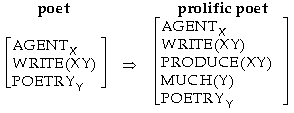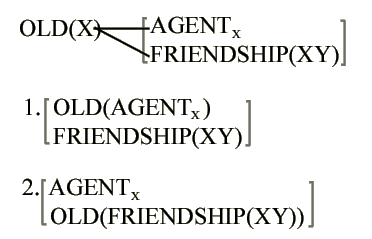- Combining Semantic Features.
When words are combined in phrases, the entire definition of one word may combine with the entire definition of the other. Consider the NP handsome sailor in the sentence A handsome sailor passed by. Assuming handsome and sailor are defined roughly as they are below, here is how their semantic features (categories) compose to form the meaning of the phrase:Meanings are not stacked one on the other; rather, the features of one word's definition become arguments of the predicate of the other.
- Derived Features.
Here is slightly more complicated example: John is a prolific writer. Assume that the definition of writer comes from the combination of:
writer : [WRITE(AGENTXY)] from
In other words, a writer is an agent (object that acts) that writes. (The sub-X indicates that this meaning must be the first argument of some predicate and not the second. See why?)
write : [WRITE(XY)]
-er : [AGENTX]

Notice that the predicate argument structure explains both A+N and A+V constructions: John writes prolifically : John is a prolific writer. Everything looks fairly straghtforward. But wait, here's a problem.
- Hidden Features.
The phrase John is a prolific poet also implies that John writes prolifically but where does the meaning of write come from here? The word write is not part of this phrase. The paraphrase of this phrase is 'John writes poetry prolifically'.
Just remember that at the semantic level we are dealing solely with semantic categories and their relationship. A semantic feature (category) may be present in the definition of a word without any phonological or syntactic representation associated with it.
- The Nature of Ambiguity.
The phrase criminal lawyer has about three different meanings, two of which are obvious: 'a lawyer who practices criminal law' is the most common interpretation but 'a lawyer who is criminal' is another. How does this ambiguity come about? First, assume that criminal and lawyer have the following definitions in our mental lexicon.criminal: [CRIMINAL(X)]


PARAPHRASE: a criminal person who practices law

PARAPHRASE: a person who practices law criminally

PARAPHRASE: a person who practices criminal law
How do we explain the ambiguity of old friend: "a (perhaps recent)
friend who is old" versus "a (perhaps young) person who has been your friend
for a long time"?

So, what we are saying when we say old friend is either "an old agent
(person) involved in a friendship" or "an agent (person) involved in an
old friendship"? Does that capture the ambiguity?
- Garden Path Sentences
- The horse walked past the barn fell.
- The boat floated down the river sank.
- The cotton shirts are made from comes from Arizona
- The man weighed 150 lbs of grapes
- The Spanish people speak today is atrocious
- Jokes
- Did you hear about the Norwegian who got a snowmobile for his wife?
- I always wear pajamas. Once when I was in India, I saw an elephant in my pajamas. What he was doing in my pajamas, I can't imagine.
- Why is it impossible to starve on the beach?
- A termite walks into a bar and says "Where's the bar tender?"
Semantic structure is generated by composing the semantic features of words in syntactic structures. The syntactic structures provides the semantic component with basic information about how the concepts associated with words are organized, but the semantic component has its own rules of combination. We must keep in mind that the semantic component operates solely on semantic features (categories), combining them according to its own rules which are wholly independent of those of syntax.